

R2 Dfs NamespaceReplication and administration possible bug or by design - Mombu the Microsoft Forum. I agree that what you are seeing can be misleading, but it is by design.
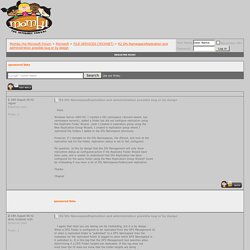
When a DFS Folder is configured to be replicated from the DFS Management UI or when a replicated folder is "published" to a DFS Namespace then the metadata for the replicated folder is tagged to show which DFS Namespace is it published in. It is this tag that the DFS Management tool searches when determining if a DFS Folder targets are replicated. If this tag does not exist then the UI does not know that the folder targets are being replicated. This is done mainly for performance reasons. Without this approach the UI would need to contact each individual folder target to determine its replication status before showing the folders in the UI. Please see the following KB article which gives some additional details and resolution steps: -- Drew McDaniel Microsoft Branch Office PM This posting is provided "AS IS" with no warranties, and confers no rights.
Viewing the "Replication" tab for a replicated folder target in the DFS "Namespaces" node in the DFS console says replication not configured. On a server 2008 R2 box I setup a DFS folder folder in a namespace and then manually setup it up for replication in the "replication" node of the DFS console.
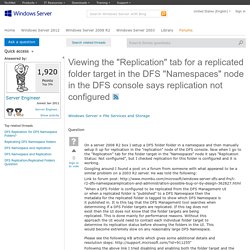
Now when I go to the "Replication" tab for the folder target in the "Namespaces" node it says "Replication Status: Not configured", but I checked replication for this folder is configured and it is working. Googling around I found a post on a forum from someone with what appeared to be a similar problem on a 2003 R2 server. Tuning replication performance in DFSR (especially on Win2008 R2) - Ask the Directory Services Team. Hi all, Ned here again.
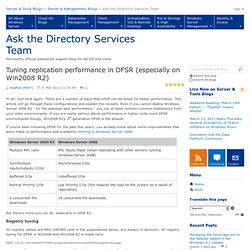
There are a number of ways that DFSR can be tuned for better performance. This article will go through these configurations and explain the caveats. Even if you cannot deploy Windows Server 2008 R2 - for the absolute best performance - you can at least remove common bottlenecks from your older environments. If you are really serious about performance in higher node count DFSR environments though, Win2008 R2’s 3rd generation DFSR is the answer. But there’s more you can do, especially in 2008 R2. Registry tuning. Where’s my file? Root cause analysis of FRS and DFSR data deletion - Ask the Directory Services Team.
Hi, Ned here.

In the Directory Services support space here at Microsoft, we are often contacted by customers for disaster recovery scenarios. We’re also brought in for deeper forensic analysis of what lead to a problem. Today we’re going to talk about a situation that covers both: A customer has seen some critical data go missing.That data was replicated via the File Replication Service (FRS) or the Distributed File System Replication (DFSR) Service.Before they restore the data with their backup copy, they want to have root cause on who deleted what and where it started. We can’t do this after restoring data because our whole audit trail will of course be destroyed within the respective JET databases. Three ways to design your DFS Namespaces - Jose Barreto's Blog. DFS: Properties cannot be set on the namespace server - Access is denied - briantist.com.
Complete Step by Step to Remove an Orphaned Domain Controller - AD and Exchange Quantum Singularity. Complete Step by Step to Remove an Orphaned Domain controller Ace Fekay, MCT, MVP, MCITP EA, Exchange 2010 Enterprise Administrator, MCTS Windows 2008, Exchange 2010 & Exchange 2007, MCSE 2003/2000, MCSA Messaging 2003Microsoft Certified TrainerMicrosoft MVP: Directory ServicesActive Directory, Exchange and Windows Infrastructure Engineer Published 10/5/2010Revamped 11/3/2010 - Changed the steps to make more sense and easier to follow Preface I think at this time you're probably thinking, "What, another blog on how to remove an Orphaned DC?

" I know. In a nutshell, I wrote this is in response to questions that have come up numerous times in the AD NNTP newsgroups and Microsoft Social Forums. To point out, many of the steps were taken from the following link, but I've extrapolated the steps and added additional information, links, and explanations. How to remove completely orphaned Domain Controller Should I repair the DC or simply dump it and create a new one? Good question. Was DNS installed? Active Directory Site Topology, Not Just for DCs. Mark here again.
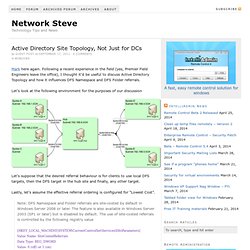
Following a recent experience in the field (yes, Premier Field Engineers leave the office), I thought it’d be useful to discuss Active Directory Topology and how it influences DFS Namespace and DFS Folder referrals. Let’s look at the following environment for the purposes of our discussion. DFS Referrals and IPv6: Outta site! - Ask the Directory Services Team. How Client Failback Works In DFS Namespaces. Hi, this is Sanjoy Chatterjee, program manager for DFS Namespaces here to talk about client failback.
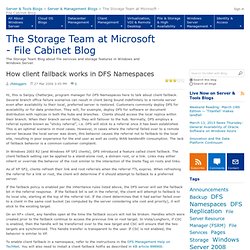
Several branch office failure scenarios can result in client being bound indefinitely to a remote server even after availability to their local, preferred server is restored. Customers commonly deploy DFS for availability or for data protection. They will, for example, deploy DFS for software or document distribution with replicas in both the hubs and branches. Clients should access the local replica within their branch. When their branch server fails, they will failover to the hub. In Windows 2003 R2 (and Windows XP SP2 clients), DFS introduced a feature called client failback.
As of XP SP2, clients refresh their link and root referrals when the referral TTL expires. Optimizing DFS Referrals: SiteCostedReferrals and PreferLogonDC - AD Troubleshooting. In a multi-site infrastructure you would under most circumstances want to make sure that the client is accessing Sysvol and Netlogon from a local DC, typically the logon server – or failing that to use the closest DC as determined by the replication costs defined on the site links in AD Sites & Services.

Two registry keys enable this functionality – they are however off by default (on W2k3 and W2k8 DC's) which means that the list of DFS referrals will be sorted with the DC’s in the same site first (in random order) and other out-of-site DC’s in semi-random order (this is assuming site & subnet configuration for clients and DC’s is correct). A domain controller that is passing a DFS referral (for Sysvol or Netlogon) to a client will by default not have any preference to put itself at the top of the referral list - you'll potentially get any DC in the same site at the top of the list. Setting PreferLogonDC on the DC’s makes the DC do just that for SYSVOL and Netlogon however. O’DFS Shares! Where Art Thou? – Part 1/3 - Ask the Directory Services Team. Hello, this is Sabin and Shravan from the Microsoft Directory Services Support team.
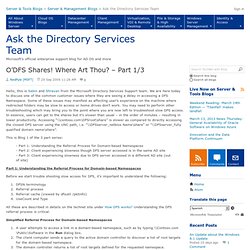
We are here today to discuss one of the common customer issues where they are seeing a delay in accessing a DFS Namespace. Some of these issues may manifest as affecting user’s experience on the machine where redirected folders may be slow to access or home drives don’t work. You may need to perform other troubleshooting which may bring you to the point where you are now left to troubleshoot slow DFS access.
In essence, users can get to the shares but it’s slower than usual – in the order of minutes – resulting in lower productivity. Accessing “\\contoso.com\DFSroot\share” is slower as compared to directly accessing the closest DFS server using the UNC path, i.e. Common DFSN Configuration Mistakes and Oversights - Ask the Directory Services Team. Hello all, Dave here again.
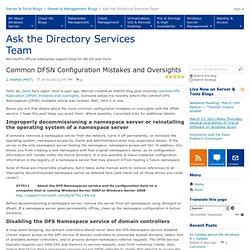
Over a year ago, Warren created an ASKDS blog post covering common DFS Replication (DFSR) mistakes and oversights. Someone asked me recently where the common DFS Namespaces (DFSN) mistakes article was located. Well, here it is now... Below you will find details about the more common configuration mistakes or oversights with the DFSN service. I hope this post helps you avoid them. If someone removes a namespace server from the network, turns it off permanently, or reinstalls the operating system, namespace access by clients and administrators alike may experience delays. Five ways to check your DFS-Namespaces (DFS-N) configuration with the DFSDIAG.EXE tool - Jose Barreto's Blog. C-BIT:MS-KB:How to configure DFS to use fully qualified domain names in referrals - 26.03.2014 16:10:00 (CET) The Basics of the Windows Server 2008 Distributed File System (DFS) - Jose Barreto's Blog. Overview In this blog post, we’ll cover the basics of the Distributed File System (DFS) in Windows Server 2008, which offers users simplified access to a set of file shares and helps administrators easily maintain the file server infrastructure behind those file shares, including options for load sharing, replication and site awareness.
Many File Servers and File Shares It’s a common scenario. Over time, a company ends up with a large number of file servers that were created at different times and by different teams. The users are left to figure out where their files are stored, mapping many drives to file shares and learning complex UNC paths like \\server23\ffiles and \\finance.asia.company.com\spreadsheets and even something like \\10.1.23.45\scratch. You also probably heard the proposition to invest in a complex project to consolidate everything into a large file server or NAS appliance.
It turns out it doesn’t have to be that way. Windows Server DFS Namespaces (DFS-N) Reference - Jose Barreto's Blog.